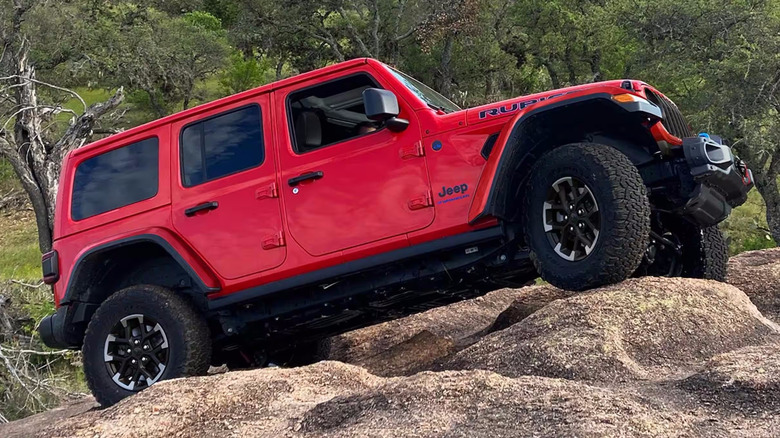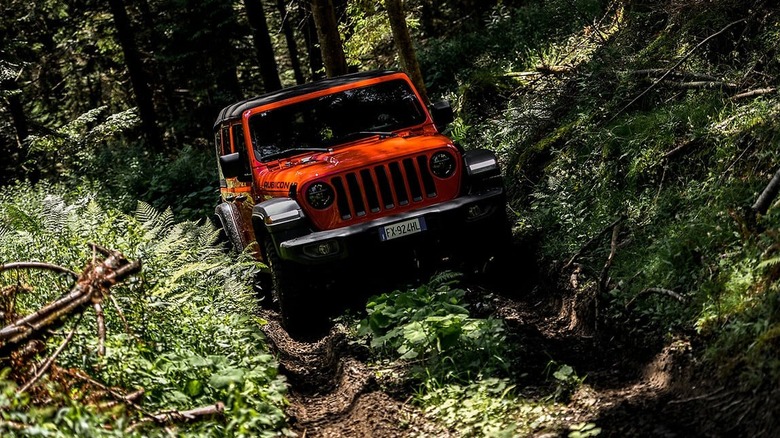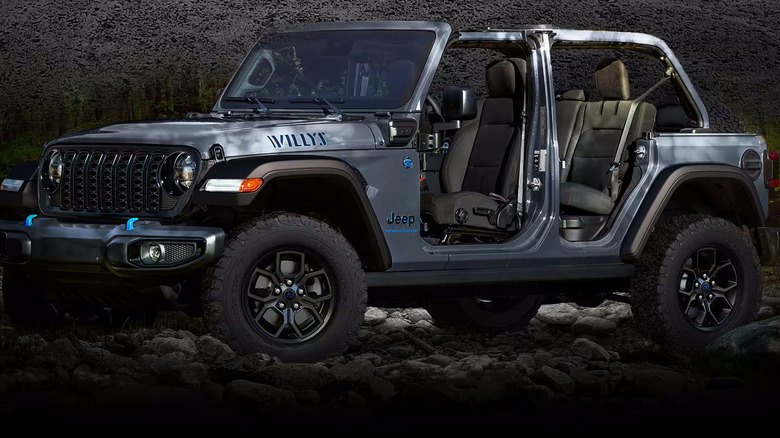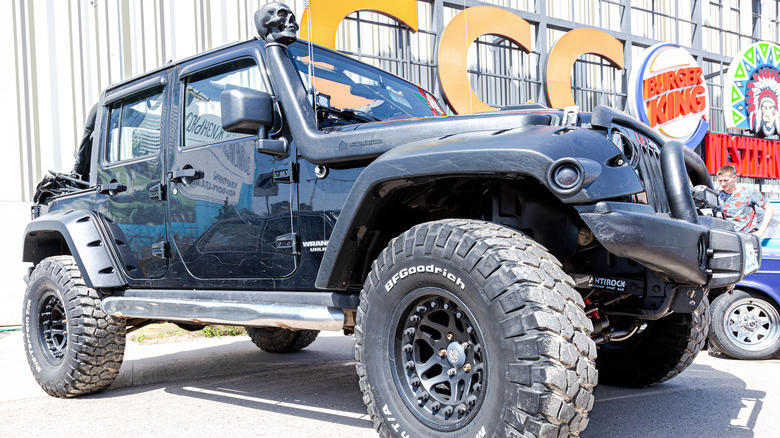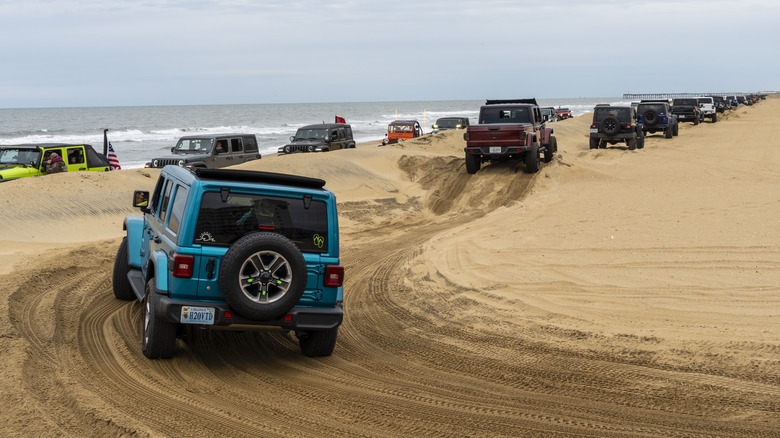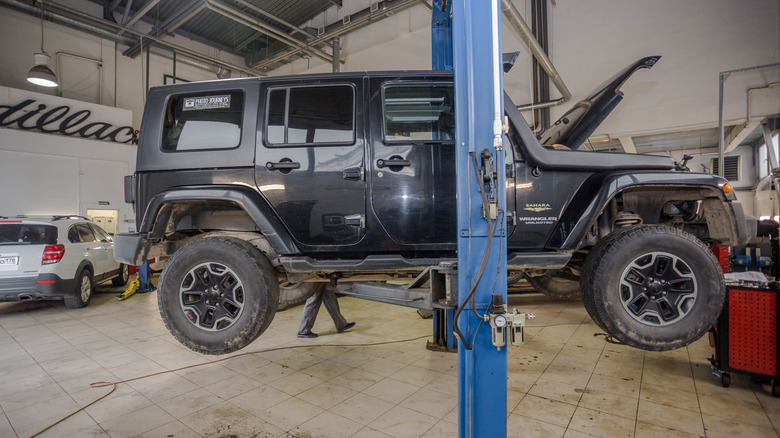Pros & Cons Of Owning A Jeep Wrangler
The Jeep Wrangler was born in 1987, the same year Chrysler bought the brand along with everything else AMC owned. The Wrangler was a replacement for the CJ-7, which had origins tracing back to World War II, when Willys built a light troop and gear mover for the U.S. Army. All-time Wrangler sales hit the 5 million mark in 2023 when a customer in Camden, New Jersey, drove home their 20th Anniversary Edition Wrangler Rubicon 4xe. The Wrangler is currently in its fourth generation (with some being better than others), and it got a major refresh for the 2024 model year.
The 2024 Wrangler lineup includes the hemi-powered Rubicon 392 we test drove, the hybrid Rubicon 4xe, and a less exciting version with a 3.8 liter V6 under the hood. Jeeps have evolved quite a bit since the days of the first CJs, but they are still formidable off-roaders. Despite the Wrangler's advancements over the years, it still comes with compromises due to its utilitarian build. If you're considering buying a Wrangler, here are the pluses and minuses you should ponder before signing on for years of payments.
You can go almost anywhere in a Wrangler
The first military Jeep was named the Quad after its four-wheel drive system, and the MA and MB that followed crawled through the mud and muck on European and African battlefields. The primary draw of the modern Wrangler remains its all-terrain capability, and Jeep has given the 2024 version some serious off-road chops. Every Wrangler comes with Jeep's Trail Rated badge, indicating it has met or exceeded minimum standards for traction, articulation, maneuverability, ground clearance, and ability to cross deep water.
The Wrangler Willys edition comes with 33-inch off-road tires, a locking rear axle, heavy-duty Rubicon shocks, and rock rails. The Rubicon 392 has 35-inch tires that give it a 12.9-inch ground clearance and the ability to cross 34 inches of water. Jeep also offers a steel front bumper with an integrated 8,000-pound Warn winch as an option on all trims, but with the Wrangler's ability to traverse mud, sand, and pretty much any other terrain on Earth, you'll probably be using it more to rescue others than to pull yourself out of trouble.
Wranglers come with a high purchase price
The base price of a 1987 Wrangler was $10,274, which equates to about $29,000 in 2024. The cheapest current Wrangler is the two-door Sport, which will set you back almost $34,000 when destination charges are added to the base price of $31,995. The four-door Sport starts at $36,595 and prices climb steeply from there. The four-door Willys edition shown above starts at just under $47,000, and the Rubicon 392 Final Edition, which will be the last hemi-powered Wrangler, requires an investment of about $102,000.
For that price, you could buy any three of the models on our list of 2024's cheapest electric cars or an equal selection from the six lowest-priced all-wheel drive models on the market today. The Rubicon 392 Final Edition has a base price of $99,995, but you have to pay an extra $595 if you want it in any color other than white, plus that pesky $1,895 destination charge. If you can afford this model, the limited run of 3,700 units makes the Final Edition a fun nest egg that should appreciate in value in the coming years.
There are many customization options
While the Wrangler is a capable vehicle as issued from the factory, there exists a robust supply of aftermarket upgrades and accessories to make your Jeep your own. Wrangler owners spend an average of $800 each year adding extras to their Jeeps like off-road lighting, intake snorkels, lift kits, and custom bumpers. Many of these upgrades are geared for off-roading.
You can increase the ride height of your Wrangler with a body or suspension lift kit and larger tires, add rocker guards to protect from dents and dings while crawling on rocky terrain, or install an air compressor to re-inflate your tires after airing down for better traction. You can add a rooftop tent for overnight excursions, and light bars help illuminate trails or remote campsites at night. You don't have to be an off-road warrior to customize your Wrangler. You can also add small personal touches, like spare tire covers that show your hippie or patriotic side, affinity for a sports team, or fascination with Bigfoot or aliens.
Unfavorable safety ratings reduce the Wrangler's appeal
The Wrangler's ability to perform well off-road is far less important than its ability to protect occupants in the event of a crash, and in that respect there is plenty to be desired. The Wrangler was graded "marginal" by the IIHS for its side and small front overlap crash protection and "poor" for moderate front overlap protection, which is the crash test depicted in the photo above. In this test, the driver's side curtain airbag failed to deploy, and the passenger seated behind the driver was deemed vulnerable to head, neck, chest, and abdominal injuries. In the side-impact test, the rear passenger's head made contact with the door frame.
On Wrangler models with the oxymoronically named Advanced Safety Group Package, the headlights were found to be unable to light the road ahead adequately, especially on curves. The NHTSA rated the 2024 Wrangler four out of five stars for frontal crashes and three out of five for rollovers.
You get fellowship with other Jeepers
If you can keep your Wrangler out of a dangerous crash, you'll enjoy becoming part of a community of millions of Wrangler owners. Be prepared to wave at other Wrangler drivers and be greeted by them in the same way. The "Jeep Wave" is believed to have originated with Army personnel during wartime and was brought stateside when the CJ models hit public roads. It can range from two fingers subtly raised from the steering wheel to both hands enthusiastically hurled above the roofline, as pictured above. Driving a Wrangler or CJ should earn you a wave from fellow Jeepers, and you can also take part in the newer tradition of leaving rubber ducks on Wranglers you see in your travels.
The spirit of Jeep community also extends to hundreds of owner groups around the world, and you probably won't have to go far to find a Jeep meetup or trail ride near you. The Jeepers Jamboree is a three- or four-day trip over the Rubicon Trail in the Sierra Nevada Mountains that has been held since 1952, and the annual three-day Jeep Jamboree is a less grueling and more family-friendly gathering for Jeep owners. All three 2024 events are scheduled for late July and early August; entry fees cover meals, land use fees, guides, and emergency assistance.
Reliability has declined over the years
First and second generation Wranglers benefitted from durable drivetrain components like the legendary 4.0 liter I6 engine and New Process 231 transfer case, but the 4.0 was dropped in 2006 in favor of a 3.8 liter V6 that doesn't enjoy as favorable a reputation. The 3.8 is known to burn oil and is prone to developing cracks in the exhaust manifolds. It was dropped after the 2011 model year in favor of the 3.6 liter Pentastar V6, which has problems of its own. The 2014 to 2020 Wranglers with the Pentastar 3.6 were part of a class-action lawsuit over faulty rocker arm rollers, which could work loose and lead to metal debris from the cam and rocker arms damaging the engine.
Like its predecessor, the Pentastar V6 can also develop exhaust manifold cracks and burn excessive amounts of oil. The 2020 to 2023 Wranglers have been the subject of more than three dozen NHTSA recalls, and owners have lodged more than 1,000 complaints with the agency. RepairPal gives the Wrangler a reliability rating of 3.5 out of 5, which places it 25th out of 26 compact SUVs. If you want a truly dependable Wrangler, you're best to seek out a first-generation YJ or second-gen TJ, both of which can be found for well under $10,000. That leaves you plenty of room in your budget for upgrades, unanticipated repairs, rubber ducks, and admission to the Jeep Jamboree.
